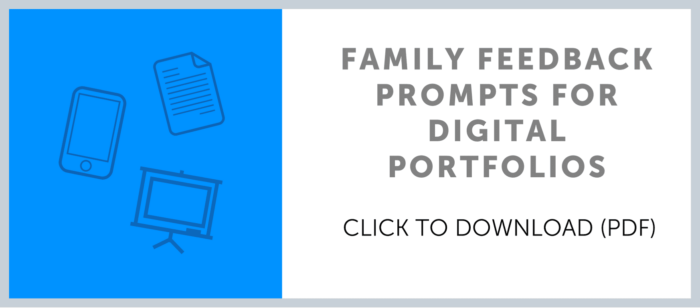A Comprehensive Guide to Digital Portfolios: How Families Can Support Their Child's Learning in the Classroom

Digital portfolios are becoming an increasingly popular way for teachers to encourage capturing and documentation of learning, prompting meaningful reflection, and providing ongoing, formative feedback.
But for many of us, this is a new concept from when we were in school.
Back in my day, I recall putting together a physical portfolio for an eighth-grade capstone project. I purchased a black three-ring binder, created chapters on each of my elementary school accomplishments in a word processor, and scrapbooked together artifacts of learning.
Today, thanks to many improvements in technology, digital portfolios can be a powerful classroom tool that students use every day.
However, where students may no longer need to be crafty, they now need to be savvier with digital tools.
For parents, guardians, and family members of students who are inundated with digital tools and social media, it can be overwhelming to advise and guide on products you’ve never even heard of. So, let's go through some tips for family members.
What is a digital portfolio in K-12 education?
A digital portfolio is a body of student work that can take on a variety of formats and showcase growth, reflection, and accomplishment. (Read: “What is a digital portfolio for the classroom?”)
The use cases can vary greatly depending on the class, the student’s age, and the teacher. A capstone or graduation projects that showcase highlights from elementary school will be different than a digital portfolio used to capture and reflect on daily learning throughout the year. The contents of a digital portfolio serve as data to inform formative assessment. Unlike traditional evaluations, formative assessment is ongoing, allowing teachers to identify areas where your student may be struggling or excelling. For example, if a student does not meet the curricular objectives in math throughout the term, this may indicate a need for extra support or enrichment on specific concepts or skills.
Furthermore, digital portfolios are dynamic and collaborative. Teachers and families alike are able to leverage this powerful student-centric tool to analyze patterns or trends beyond academics. Both parties can report on students' behavior, such as incidents of disruptive behavior or instances of positive behavior. This data can help identify areas where students may need social-emotional support or behavioral intervention.
Additionally, teachers and families can track students' participation in class discussions, group work, and other activities. Low participation may indicate a need for extra support or encouragement to engage in class.
Teachers and families can also track students' progress towards their personal and academic goals. This data can help identify areas where students may need extra support or encouragement to achieve their goals. Ultimately, digital portfolios prioritize student success by providing opportunities to celebrate areas of growth and achievement to motivate your student to continue improving.
How will my student's portfolio be evaluated?
There are three main ways student portfolios can be evaluated.
- Show the Process: Students collect and store evidence of learning and reflect on the process in a continuous cycle. In this case, the reflection on the learning may be evaluated as well as the work.
- Show the Progress: Students document growth and changes in their work over time to show progress. In this case, the progress over different versions and assignments may be considered in the evaluation.
- Show the Product: Students curate projects, learnings, and evidence into a final “polished” product. In this case, the final artifacts and the overall story of the different pieces of the portfolio will be evaluated. (Read: "The three ways teachers use portfolios in the classroom.")
Be sure to check in with assignment details or contact your student's teacher if you’re unsure of the learning outcomes and purpose of a student portfolio.
What should my student’s portfolio include?
To create a comprehensive digital portfolio, students can incorporate various artifacts of their work such as images, text, audio files, video files, and other documents like PDF and Microsoft Word files using tools like SpacesEDU. The types of work that students can exhibit in their portfolios may vary depending on their grade level and subject area. However, understanding how your student's teacher plans to use their portfolio can help make informed recommendations on what to include. In general, your students can post these types of documentation:
- Work samples: Students can include their best work from various subjects and projects, such as essays, presentations, videos, artwork, projects, etc.
- Reflections: Students can write reflections on their learning experiences, highlighting what they learned, how they grew, and what challenges they faced. These self-reflections can be in the form of blog posts, journal entries, or video reflections.
- Goals: Students can set personal and academic goals for themselves and track their progress towards achieving them.
When curating and organizing their digital portfolio, your student should consider the following tips:
- Choose their best work: Students should select their best work to showcase in their portfolio. They should consider the quality of their work, as well as its relevance to their goals, interests, and teacher guidelines.
- Organize their work thematically: Students can organize their work thematically, grouping similar items together. For example, they could dedicate posts for writing, another for artwork, and a third for STEM projects.
- Include reflections: Students should include reflections in their posts, explaining what they learned, what they would do differently, and how they plan to apply what they learned in the future.
- Keep it updated: Students should keep their portfolio updated regularly, adding new work as they complete it and reflecting on older work that no longer represents their best efforts.
How can I help my student with their portfolio?
Using portfolios in the classroom offers many benefits, one of which is to engage families and encourage their participation in their student's learning. Digital portfolios, in particular, promote open dialogues among students, teachers, and families. By commenting on their student's portfolio artifacts, families can prompt further reflection and receive feedback directly from their student's teacher. Moreover, digital portfolios can serve as the centerpiece of parent-teacher interviews or support student-led conferences.
As students reflect on the work and progress displayed in their portfolio, families can play a crucial role in providing constructive feedback and engaging in meaningful conversations with their student. This presents an excellent opportunity to explore their student's experiences and perspectives. To start, families can discuss with their student what they excel at and enjoy doing. This helps identify their strengths and interests and aligns them with their future goals. Encouraging self-reflection is equally important. Asking questions such as "What did you learn from this experience?" or "What would you do differently next time?" helps students reflect on their progress and accomplishments.
As students identify their strengths and interests, families can encourage them to set achievable and specific goals. By breaking down these goals into smaller, manageable steps, families can offer support and motivation to their students. In summary, portfolios not only engage families but also provide an opportunity for students to reflect on their progress and accomplishments, and for families to offer support and encouragement to their children.
Tips for providing feedback on your student's learning
- Encourage the process. Rather than commenting on the final product, focus on the process of learning that leads up to the actual artifact to honor your student’s work that came before it. Focus more on perseverance and your student’s improvement over time rather than on their ability.
- Have an open dialogue. The best conversations start when asking questions to spark thinking rather than by passing judgment. Consider what your student (or their teacher) was trying to convey by posting the artifact and use one of the dialogue prompts suggested below to allow them to share their perspective.
- Avoid “yes” and “no”. Use open-ended questions that encourage your student to reflect on their learning. Try to give concrete examples when providing feedback so your student understands what you are referencing, and be mindful not to make comparisons to the work of others.
Looking for some tips on how to best provide feedback on your student's learning? We’ve got you covered. Click here to download our Family Feedback Prompts for Digital Portfolios (PDF).



